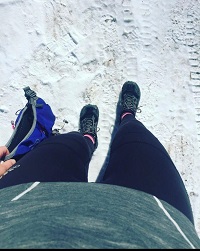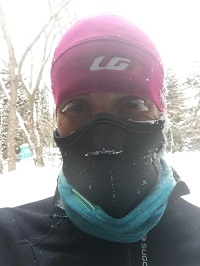Winter running can easily find you seeking the comforts of the warm indoors. Running on tracks or treadmills where the temperature and conditions are consistent, let’s face it, is a lot more pleasant!
However, being outdoors in the fresh air has a lot going for it too. Running in the winter can be a really serene getaway from the noise and the crowds that indoor training can bring. It can get us sweating under that glorious blue sky sun that winter days can be famous for. Running outdoors can let us explore all those trails that seem to take on a whole new personality when the snow cover settles in. So, let’s talk about what you need to do to take advantage of all these things and give indoor training a healthy winter rival!
Running Shoes

Running on the snow and ice means your surface just got a lot more unstable. These conditions have a nasty habit of waking up all our instabilities and highlighting any of our mechanical faults. That’s right, that otherwise dormant or controlled achilles tendinopathy, ITB syndrome, or lateral hip bursitis, just reared its ugly head! There’s no hiding these things when it gets slippery. So, first, and arguably, most important, is to get yourself in shoes that are equipped for the change in surface. There are shoes on the market that are designed with spikes, you can purchase spikes to add to any of your current shoes, or there are various models of pull-over spikes, all of which can get you the traction you’re looking for. Find the best option for you and invest in this small necessity to keep you running safely.
Running Gear
Second, make sure you dress for the weather.
- Dress for the drop in temperatures, but also dress for the cold winds that tend to creep up this time of year.
- Layer up with base layers that wick the sweat away, and top yourself with layers that break the wind from getting at your core. The layers in between should be chosen based on how much insulation you need – just remember, it’s best to feel a little cold when you first get out. Your body will warm up quickly, and it can be just as common of a mistake to over-dress as it is to under-dress.
- Then, once you’ve figured out what goes on the big parts, think about what goes on the small parts; toques, neck warmers, face masks, and gloves. All these accessories will prepare you for facing those temperatures and keeping your extremities protected.
- Remember, having a small backpack will also help if you need to start removing layers or if you need to pack a couple extra ones along.
Slow down your pace
Lastly, slow down and embrace it. Winter running simply won’t let you safely experience the paces that you’re used to hitting during drier months. You lose traction so your push-off is reduced, this makes propulsion forward and up hills a new challenge. Icy and unpredictable surfaces also force you to snug up your stride length, making each step a little smaller and covering less ground. Since you generally can’t speed this turn-over up, your overall pace will slow down too. Downhill running can become more treacherous which interferes with you opening up and plowing down those descents. All in all, it’s just slower out there. Learn to accept that and adjust your miles accordingly so you don’t just start stacking up the hours. As we talked about earlier, overuse injuries will be knocking at your door, but if you keep your overall load in check, then your odds of running through the winter in one piece just went up!

Here are some local trails I suggest trying out!
For some challenging bursts: Raven, Six Shooter, Ray Gun
For some flatter winding fun: Flat Pete, Flatter Pete, and Logarithmic
Simone van Gelder MScPT, BScKin
Physiotherapist at Pivotal Physiotherapy
